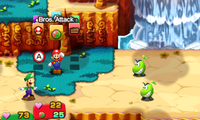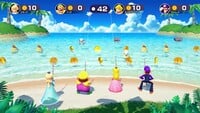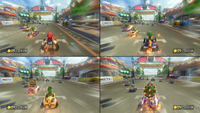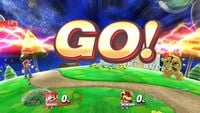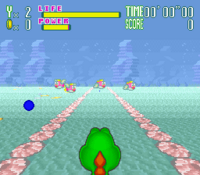Genre: Difference between revisions
Tags: Mobile edit Advanced mobile edit |
|||
| (164 intermediate revisions by 54 users not shown) | |||
| Line 1: | Line 1: | ||
'''Genres''' are different types of [[games|video games]] classified by gameplay. With over | {{see also|List of games by genre}} | ||
'''Genres''' are different types of [[List of games|video games]] classified by gameplay. With over 300 entries, the [[Super Mario (franchise)|''Super Mario'' franchise]] has included a variety of different genres. The first ''Super Mario'' games were platformers, but the series has since spun off into various other genres. | |||
== | ==Platform games== | ||
{{anchor|Platform}} | |||
[[File: | {{anchor|Platformer}} | ||
[[File:SMB Super Mushroom Screenshot.png|thumb|left|[[Mario]] in [[World 1-1 (Super Mario Bros.)|World 1-1]] of ''[[Super Mario Bros.]]'', one of the oldest and most popular side-scrolling platformers]] | |||
'''Platform games''' (often called '''platformers''') require players to control a character who traverses [[level]]s consisting of a multitude of [[platform]]s to reach or attain a particular goal. | |||
[[File:SM64BobOmbBattlefield.png|thumb|Mario running on the [[Bob-omb Battlefield]], which is a course from ''[[Super Mario 64]]'', the first three-dimensional platform game in the ''Super Mario'' franchise]] | |||
Many ''Super Mario'' games fall within the platformer genre, which itself can be divided into two sub-genres: side-scrolling and three-dimensional. '''Side-scrolling platformers''' (or '''side-scrollers''') usually allow travel in only one or two directions towards a [[Goal Pole]]. '''Three-dimensional''' (or '''3D''') '''platformers''' allow travel in any direction and usually consist of objective-based level completion. Classification is based upon movement style, so games such as ''[[New Super Mario Bros. Wii]]'' with modern three-dimensional graphics are still classified as side-scrollers. | |||
Most 3D platformers in the ''Super Mario'' franchise feature a menu for selecting what objective is to be achieved (or objectives in ''[[Super Mario Odyssey]]'') whenever Mario enters an area (except ''[[Super Mario 3D Land]]'' and ''[[Super Mario 3D World]]'', in which levels are completed by reaching a traditional Goal Pole). The player can also select objectives they have previously completed, including re-fighting bosses. | |||
Most ''[[Mario (series)| | Most platformers of the ''Super Mario'' franchise are part of the [[Super Mario (series)|''Super Mario'' series]], with the exception of ''[[Super Paper Mario]]'', which mixes platforming and RPG elements. | ||
For the list of platform games, see [[:Category:Platforming | For the list of platform games, see [[:Category:Platforming games]]. | ||
{{br}} | |||
==Role-playing games== | |||
[[File: | {{anchor|Role-playing}} | ||
Role playing games (often abbreviated as RPGs) | {{anchor|RPG}} | ||
[[File:MLSS BM Beanie battle.png|thumb|left|Mario and [[Luigi]] battling two [[Beanie]]s in the RPG ''[[Mario & Luigi: Superstar Saga + Bowser's Minions]]'']] | |||
'''Role-playing games''' (often abbreviated as '''RPGs''') are games where players act as Mario in a longform story. Traditionally, an RPG consists of two types of gameplay: an "overworld" portion where Mario moves around the game world and interacts with other game characters, and a "battle" portion where Mario fights enemies encountered in the overworld gameplay. RPGs commonly include detailed storylines and a large cast of characters. Battles usually assign all involved characters numerical stats, which are used in the battle to determine the results of attacks. [[level up|Leveling up]] is a common conceit, allowing the player to increase their stats to make the characters stronger. RPGs often have playable characters aside from Mario, who have different abilities and stats compared to him. | |||
Another common feature in RPGs is the ability to equip weapons, armor, [[clothing]], [[badge]]s, and accessories. These items can be bought at [[Item Shop|shops]] or be found in [[block]]s and [[treasure chest]]s, and often have the effect of further increasing stats. Many games have special moves, which are stronger than the normal attacks that characters use. They are learned by the characters as the player progresses through the game and cost points (e.g., [[Bros. Point]]s in the ''[[Mario & Luigi (series)|Mario & Luigi]]'' series) in order to use them. | |||
Mario's first appearance in an RPG was in ''[[Super Mario RPG: Legend of the Seven Stars]]''. Later, the [[Paper Mario (series)|''Paper Mario'' series]] and ''Mario & Luigi'' series were introduced. Role-playing games of the ''Super Mario'' franchise often contain platforming elements. For instance, Mario still jumps as his primary action in the "overworld" gameplay, and moving through areas sometimes requires jumping across platforms. Normal ''Super Mario''-franchise enemies, such as [[Goomba]]s and [[Koopa Troopa]]s, make appearances. | |||
[[ | The battle system usually involves Mario, his [[party member|partner(s)]], and enemies taking turns to attack. Attacks usually have [[Action Command]]s, meaning that the attacks are more effective if the player makes an input at the correct time during the animation. Similarly, Action Commands can be used against enemy attacks, causing them to inflict reduced damage to the player characters. | ||
RPGs | The ''Paper Mario'' series differs slightly from the other RPGs because the damage and [[Heart Point|HP]] ratio is lower and Mario and his partner always attack first. The characters' attack power is increased by collecting [[hammer]]s, boots, or [[HP-Up Heart]]s rather than leveling up. ''Paper Mario'' is also split into chapters for which stars Mario must get, and it has chapter bosses, with minibosses along the way, while neither really exists in the other RPGs; only bosses exist, identifiable by different battle theme and higher HP (and often they are characters). | ||
In the ''Mario & Luigi'' series, instead of using Action Commands to block attacks, gameplay revolves around avoiding enemy attacks. Many attacks can also be [[Counterattack|countered]], fully negating the attack and inflicting damage onto the opponent. | |||
Various other games incorporate RPG elements, stats, and levels, but they are not traditional RPGs in the sense the aforementioned series are. ''[[Puzzle & Dragons: Super Mario Bros. Edition]]'' combines the puzzle genre with the RPG genre. Enemy characters can damage the player's characters with Skills after a certain number of turns have passed. By matching [[Orbs]] in the puzzle gameplay, the player's characters can damage the enemies. Other examples of games using RPG mechanics are some of the handheld games of the [[Mario Tennis (series)|''Mario Tennis'' series]] and [[Mario Golf (series)|''Mario Golf'' series]], namely ''[[Mario Tennis (Game Boy Color)|Mario Tennis]]'' and ''[[Mario Golf (Game Boy Color)|Mario Golf]]'' for the [[Game Boy Color]], ''[[Mario Tennis: Power Tour]]'' and ''[[Mario Golf: Advance Tour]]'' for the [[Game Boy Advance]], and ''[[Mario Golf: World Tour]]'' for the [[Nintendo 3DS]]. Players can purchase equipment and level up to increase their stats as they do in an RPG, which makes the characters stronger in the sport gameplay. | |||
For the list of role-playing games, see [[:Category:Role-playing games]]. | |||
{{br}} | |||
==Party games== | |||
{{anchor|Party}} | |||
[[File:MPS Cast Aways.jpg|thumb|A screenshot of the minigame [[Cast Aways]] in the party game ''[[Mario Party Superstars]]'']] | |||
'''Party games''' are games usually involving short [[minigame]]s. This genre is dominated by the [[Mario Party (series)|''Mario Party'' series]], but the [[WarioWare (series)|''WarioWare'' series]], ''[[Itadaki Street DS]]'', and ''[[Fortune Street]]'' are also part of it. While most party games involve multiple players, some party games are single player, such as certain ''WarioWare'' games. Luck is a large factor in party games, but players must also have a certain degree of skill. Party games are usually designed for casual gameplay rather than serious competitive gameplay, although many also have story modes that can be completed. | |||
{{br}} | |||
== | ==Racing games== | ||
[[File: | {{anchor|Racing}} | ||
[[File:MK8D 4-Player Gameplay Screenshot.png|left|thumb|A race on [[GCN Yoshi Circuit|<small>GCN</small> Yoshi Circuit]] in ''[[Mario Kart 8 Deluxe]]'']] | |||
'''Racing games''' involve speedy competitions with other characters. The main objective in racing games is to reach the [[finish line (object)|finish line]] before the other racers and attain first place. Nearly all ''Super Mario'' racing games are part of the ''[[Mario Kart (series)|Mario Kart]]'' series, except for ''[[Diddy Kong Racing]]'', ''[[Diddy Kong Racing DS]]'', and ''[[Donkey Kong Barrel Blast]]''. All racing games in the ''Super Mario'' franchise involve items or power-ups that can do various things such as slow down the other racers and speed up the player. Racing games also build on this by providing battle modes in which items are used as weapons. Online racing was introduced with the release of ''[[Mario Kart DS]]'' and is integrated in every ''Super Mario'' racing game since. | |||
For the list of | For the list of racing games, see [[:Category:Racing games]]. | ||
{{br}} | |||
== | ==Sports games== | ||
[[File: | {{anchor|Sport}} | ||
{{anchor|Sports}} | |||
[[File:MSBLGameplay.jpg|thumb|Gameplay of the sports game ''[[Mario Strikers: Battle League]]'']] | |||
The ''Super Mario'' franchise contains a large number of games based on sports. Unlike most conventional sports games, ''Super Mario'' sports games feature items and obstacles. Racing and fighting games are sub-genres of sports games. The genre started with ''[[Golf]]'' for the [[Nintendo Entertainment System]]. This genre of ''Super Mario'' games did not become well-known until the release of the [[Nintendo 64]] with games such as ''[[Mario Golf (Nintendo 64)|Mario Golf]]'' and ''[[Mario Tennis (Nintendo 64)|Mario Tennis]]'' for the Nintendo 64. Currently, ''Super Mario'' sports games include [[Mario Golf (series)|golf]], [[Mario Kart (series)|racing]], [[Mario Tennis (series)|tennis]], [[Mario Strikers (series)|soccer]], [[Mario Hoops 3-on-3|basketball]], [[Super Smash Bros. (series)|fighting]], [[Mario Baseball (series)|baseball]], and [[Mario & Sonic (series)|Olympic events]]. In addition, separately from those series are the games ''[[Mario Sports Mix]]'' and ''[[Mario Sports Superstars]]'', which feature four and five sports, respectively. | |||
For the list of | For the list of sports games, see [[:Category:Sports games]]. | ||
{{br}} | |||
== | ==Puzzle games== | ||
[[File: | {{anchor|Puzzle}} | ||
[[File:Dr. Mario Miracle Cure.png|thumb|left|A screenshot from the puzzle game ''[[Dr. Mario: Miracle Cure]]'']] | |||
'''Puzzle games''' test the player's reflexes and knowledge. The objective in most ''Super Mario'' puzzle games is to clear the screen of various objects, similar to that in ''[[Tetris]]''. However, a few ''Super Mario'' puzzle games incorporate different types of gameplay, such as ''[[Mario's Picross]]'' and ''[[Yakuman DS]]''. Games belonging to this genre include the ''[[Dr. Mario (series)|Dr. Mario]]'' series, ''[[Wario's Woods (Nintendo Entertainment System)|Wario's Woods]]'', ''[[Yoshi's Cookie]]'', and ''[[Puzzle & Dragons: Super Mario Bros. Edition]]''. Puzzle games tend to feature no items and a relatively large cast of characters. | |||
For the list of puzzle games, see [[:Category:Puzzle games]]. | |||
{{br}} | |||
== | ==Fighting games== | ||
[[File: | {{anchor|Fighting}} | ||
[[File:Match Start (Mario Galaxy).jpg|thumb|A basic VS. battle in ''[[Super Smash Bros. for Wii U]]'', involving [[Mario]] and [[Bowser]]]] | |||
'''Fighting games''' pit characters against each other in combat. The objective of most fighting games is to knock out the other characters. Fighting games are a sub-genre of sports games. This genre has exclusively been a part of the crossover [[Super Smash Bros. (series)|''Super Smash Bros.'' series]]. | |||
Mario's first appearance in a fighting game was as a referee in ''{{wp|Punch-Out!! (arcade game)|Punch-Out!!}}''; additionally, the [[Punch-Out!! (Wii)|Wii game of the same name]] features [[Donkey Kong]] as a bonus opponent. Mario's first playable role in a fighting game was in ''[[Super Smash Bros.]]'', along with [[Luigi]], [[Yoshi]], and Donkey Kong. [[Bowser]], [[Princess Peach]], and [[Dr. Mario]] were later playable in ''[[Super Smash Bros. Melee]]'', and the former two returned in ''[[Super Smash Bros. Brawl]]'', along with [[Wario]] and [[Diddy Kong]] appearing as newcomers. Dr. Mario was readded as a fighter along with all aforementioned characters in ''[[Super Smash Bros. for Nintendo 3DS]]'' and ''[[Super Smash Bros. for Wii U]]'', which also introduced [[Rosalina]] and [[Bowser Jr.]] as fighters, and [[Princess Daisy]], [[King K. Rool]], and [[Piranha Plant]] made their appearances as newcomers in ''[[Super Smash Bros. Ultimate]]''. Instead of depleting the enemy's health, the player must knock the enemy off the screen. Items and obstacles are also available, whereas most fighting games do not have them. | |||
{{br}} | |||
== | ==Educational games== | ||
{{anchor|Educational}} | |||
{{anchor|Edutainment}} | |||
[[File:Mariotype.jpg|left|thumb|A game mode in ''[[Mario Teaches Typing 2]]'', which teaches the player how to type and spell]] | |||
[[File:Pink Kong Jr Math.png|thumb|Gameplay of ''[[Donkey Kong Jr. Math]]'', a game that teaches mathematics]] | |||
'''Educational games''' (specifically '''edutaining games''') are aimed at younger players and are intended to educate as well as entertain them. The premise of educational games is generally to solve mysteries or simply learn how to do something, such as typing or math. A relatively small number of games in the ''Super Mario'' franchise are educational games (including the ''[[Mario Discovery Series]]''), most of which were developed by third-party companies. | |||
For the list of educational games, see [[:Category:Educational games]]. | |||
{{br}} | |||
==Rhythm games== | |||
{{anchor|Rhythm}} | |||
[[File:DDR Super Hard Difficulty Luigi.jpg|thumb|left|[[Luigi]] dancing in ''[[Dance Dance Revolution: Mario Mix]]'']] | |||
'''Rhythm games''' are games where the player must time button presses on a game controller or {{wp|dance pad}} in order to match the beat of music played during the game and the timing of symbols that appear onscreen. There are five ''Super Mario'' rhythm games: ''[[Mario Undōkai]]'' and ''[[Dance Dance Revolution: Mario Mix]]'' are based on the ''{{wp|Dance Dance Revolution}}'' series, and the [[Donkey Konga (series)|''Donkey Konga'' series]] (''[[Donkey Konga]]'', ''[[Donkey Konga 2]]'', and ''[[Donkey Konga 3 JP]]'') is based on the ''{{wp|Taiko no Tatsujin}}'' series by the same developers and utilizes the [[Nintendo GameCube#DK Bongos|DK Bongos]] as a controller. All of these games feature minigames in addition to the rhythm-based gameplay, and with the exception of ''Mario Undōkai'', they can be played with a standard [[Nintendo GameCube]] controller. | |||
In addition to these games, characters from the ''WarioWare'' series make appearances in the game ''[[Rhythm Heaven Megamix]]''. | |||
{{br}} | |||
==Rail shooters== | |||
{{anchor|Rail shooter}} | |||
[[File:Yoshi's Safariscreenshot.png|thumb|Mario riding [[Yoshi]] in a first-person view in ''[[Yoshi's Safari]]'']] | |||
'''Rail shooters''' are games played from a first-person perspective, where the player must shoot all the enemies on the screen while following a specific route. The only rail shooters in the ''Super Mario'' franchise are ''[[Yoshi's Safari]]'', which requires the use of the [[Super Scope]] in single-player mode, and ''[[Luigi's Mansion Arcade]]'', which uses the arcade machine itself as a controller. | |||
{{br}} | |||
==Turn-based tactics games== | |||
{{anchor|Turn-based tactics}} | |||
{{anchor|Tactics}} | |||
[[File:Mario Rabbids Sparks of Hope battle.png|thumb|left|Gameplay of the turn-based tactics game ''[[Mario + Rabbids Sparks of Hope]]'']] | |||
'''Turn-based tactics games''' involve turn-based combat gameplay characteristic of an RPG, usually in a warfare-like scenario. The combat involves the player tactfully positioning their characters to attack and defend against enemies. The only games in the ''Super Mario'' franchise with this genre are those in the [[Mario + Rabbids (series)|''Mario + Rabbids'' series]]. | |||
The ''Mario Party'' series does also include game modes that merge aspects of both the turn-based tactics and party genres, specifically [[Mario_Party:_Star_Rush#Toad_Scramble|Toad Scramble]] in ''Mario Party: Star Rush'' and [[Super Mario Party#Partner Party|Partner Party]] in ''Super Mario Party''. | |||
[[Category:Terms]] | [[Category:Terms]] | ||
Latest revision as of 18:14, November 9, 2024
- See also: List of games by genre
Genres are different types of video games classified by gameplay. With over 300 entries, the Super Mario franchise has included a variety of different genres. The first Super Mario games were platformers, but the series has since spun off into various other genres.
Platform games[edit]
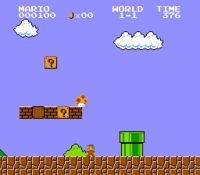
Platform games (often called platformers) require players to control a character who traverses levels consisting of a multitude of platforms to reach or attain a particular goal.

Many Super Mario games fall within the platformer genre, which itself can be divided into two sub-genres: side-scrolling and three-dimensional. Side-scrolling platformers (or side-scrollers) usually allow travel in only one or two directions towards a Goal Pole. Three-dimensional (or 3D) platformers allow travel in any direction and usually consist of objective-based level completion. Classification is based upon movement style, so games such as New Super Mario Bros. Wii with modern three-dimensional graphics are still classified as side-scrollers.
Most 3D platformers in the Super Mario franchise feature a menu for selecting what objective is to be achieved (or objectives in Super Mario Odyssey) whenever Mario enters an area (except Super Mario 3D Land and Super Mario 3D World, in which levels are completed by reaching a traditional Goal Pole). The player can also select objectives they have previously completed, including re-fighting bosses.
Most platformers of the Super Mario franchise are part of the Super Mario series, with the exception of Super Paper Mario, which mixes platforming and RPG elements.
For the list of platform games, see Category:Platforming games.
Role-playing games[edit]
Role-playing games (often abbreviated as RPGs) are games where players act as Mario in a longform story. Traditionally, an RPG consists of two types of gameplay: an "overworld" portion where Mario moves around the game world and interacts with other game characters, and a "battle" portion where Mario fights enemies encountered in the overworld gameplay. RPGs commonly include detailed storylines and a large cast of characters. Battles usually assign all involved characters numerical stats, which are used in the battle to determine the results of attacks. Leveling up is a common conceit, allowing the player to increase their stats to make the characters stronger. RPGs often have playable characters aside from Mario, who have different abilities and stats compared to him.
Another common feature in RPGs is the ability to equip weapons, armor, clothing, badges, and accessories. These items can be bought at shops or be found in blocks and treasure chests, and often have the effect of further increasing stats. Many games have special moves, which are stronger than the normal attacks that characters use. They are learned by the characters as the player progresses through the game and cost points (e.g., Bros. Points in the Mario & Luigi series) in order to use them.
Mario's first appearance in an RPG was in Super Mario RPG: Legend of the Seven Stars. Later, the Paper Mario series and Mario & Luigi series were introduced. Role-playing games of the Super Mario franchise often contain platforming elements. For instance, Mario still jumps as his primary action in the "overworld" gameplay, and moving through areas sometimes requires jumping across platforms. Normal Super Mario-franchise enemies, such as Goombas and Koopa Troopas, make appearances.
The battle system usually involves Mario, his partner(s), and enemies taking turns to attack. Attacks usually have Action Commands, meaning that the attacks are more effective if the player makes an input at the correct time during the animation. Similarly, Action Commands can be used against enemy attacks, causing them to inflict reduced damage to the player characters.
The Paper Mario series differs slightly from the other RPGs because the damage and HP ratio is lower and Mario and his partner always attack first. The characters' attack power is increased by collecting hammers, boots, or HP-Up Hearts rather than leveling up. Paper Mario is also split into chapters for which stars Mario must get, and it has chapter bosses, with minibosses along the way, while neither really exists in the other RPGs; only bosses exist, identifiable by different battle theme and higher HP (and often they are characters).
In the Mario & Luigi series, instead of using Action Commands to block attacks, gameplay revolves around avoiding enemy attacks. Many attacks can also be countered, fully negating the attack and inflicting damage onto the opponent.
Various other games incorporate RPG elements, stats, and levels, but they are not traditional RPGs in the sense the aforementioned series are. Puzzle & Dragons: Super Mario Bros. Edition combines the puzzle genre with the RPG genre. Enemy characters can damage the player's characters with Skills after a certain number of turns have passed. By matching Orbs in the puzzle gameplay, the player's characters can damage the enemies. Other examples of games using RPG mechanics are some of the handheld games of the Mario Tennis series and Mario Golf series, namely Mario Tennis and Mario Golf for the Game Boy Color, Mario Tennis: Power Tour and Mario Golf: Advance Tour for the Game Boy Advance, and Mario Golf: World Tour for the Nintendo 3DS. Players can purchase equipment and level up to increase their stats as they do in an RPG, which makes the characters stronger in the sport gameplay.
For the list of role-playing games, see Category:Role-playing games.
Party games[edit]
Party games are games usually involving short minigames. This genre is dominated by the Mario Party series, but the WarioWare series, Itadaki Street DS, and Fortune Street are also part of it. While most party games involve multiple players, some party games are single player, such as certain WarioWare games. Luck is a large factor in party games, but players must also have a certain degree of skill. Party games are usually designed for casual gameplay rather than serious competitive gameplay, although many also have story modes that can be completed.
Racing games[edit]
Racing games involve speedy competitions with other characters. The main objective in racing games is to reach the finish line before the other racers and attain first place. Nearly all Super Mario racing games are part of the Mario Kart series, except for Diddy Kong Racing, Diddy Kong Racing DS, and Donkey Kong Barrel Blast. All racing games in the Super Mario franchise involve items or power-ups that can do various things such as slow down the other racers and speed up the player. Racing games also build on this by providing battle modes in which items are used as weapons. Online racing was introduced with the release of Mario Kart DS and is integrated in every Super Mario racing game since.
For the list of racing games, see Category:Racing games.
Sports games[edit]
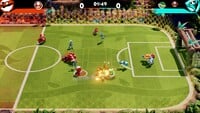
The Super Mario franchise contains a large number of games based on sports. Unlike most conventional sports games, Super Mario sports games feature items and obstacles. Racing and fighting games are sub-genres of sports games. The genre started with Golf for the Nintendo Entertainment System. This genre of Super Mario games did not become well-known until the release of the Nintendo 64 with games such as Mario Golf and Mario Tennis for the Nintendo 64. Currently, Super Mario sports games include golf, racing, tennis, soccer, basketball, fighting, baseball, and Olympic events. In addition, separately from those series are the games Mario Sports Mix and Mario Sports Superstars, which feature four and five sports, respectively.
For the list of sports games, see Category:Sports games.
Puzzle games[edit]
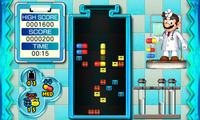
Puzzle games test the player's reflexes and knowledge. The objective in most Super Mario puzzle games is to clear the screen of various objects, similar to that in Tetris. However, a few Super Mario puzzle games incorporate different types of gameplay, such as Mario's Picross and Yakuman DS. Games belonging to this genre include the Dr. Mario series, Wario's Woods, Yoshi's Cookie, and Puzzle & Dragons: Super Mario Bros. Edition. Puzzle games tend to feature no items and a relatively large cast of characters.
For the list of puzzle games, see Category:Puzzle games.
Fighting games[edit]
Fighting games pit characters against each other in combat. The objective of most fighting games is to knock out the other characters. Fighting games are a sub-genre of sports games. This genre has exclusively been a part of the crossover Super Smash Bros. series.
Mario's first appearance in a fighting game was as a referee in Punch-Out!!; additionally, the Wii game of the same name features Donkey Kong as a bonus opponent. Mario's first playable role in a fighting game was in Super Smash Bros., along with Luigi, Yoshi, and Donkey Kong. Bowser, Princess Peach, and Dr. Mario were later playable in Super Smash Bros. Melee, and the former two returned in Super Smash Bros. Brawl, along with Wario and Diddy Kong appearing as newcomers. Dr. Mario was readded as a fighter along with all aforementioned characters in Super Smash Bros. for Nintendo 3DS and Super Smash Bros. for Wii U, which also introduced Rosalina and Bowser Jr. as fighters, and Princess Daisy, King K. Rool, and Piranha Plant made their appearances as newcomers in Super Smash Bros. Ultimate. Instead of depleting the enemy's health, the player must knock the enemy off the screen. Items and obstacles are also available, whereas most fighting games do not have them.
Educational games[edit]
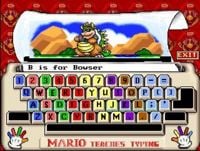
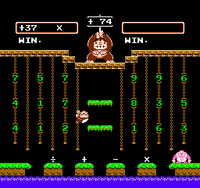
Educational games (specifically edutaining games) are aimed at younger players and are intended to educate as well as entertain them. The premise of educational games is generally to solve mysteries or simply learn how to do something, such as typing or math. A relatively small number of games in the Super Mario franchise are educational games (including the Mario Discovery Series), most of which were developed by third-party companies.
For the list of educational games, see Category:Educational games.
Rhythm games[edit]
Rhythm games are games where the player must time button presses on a game controller or dance pad in order to match the beat of music played during the game and the timing of symbols that appear onscreen. There are five Super Mario rhythm games: Mario Undōkai and Dance Dance Revolution: Mario Mix are based on the Dance Dance Revolution series, and the Donkey Konga series (Donkey Konga, Donkey Konga 2, and Donkey Konga 3 JP) is based on the Taiko no Tatsujin series by the same developers and utilizes the DK Bongos as a controller. All of these games feature minigames in addition to the rhythm-based gameplay, and with the exception of Mario Undōkai, they can be played with a standard Nintendo GameCube controller.
In addition to these games, characters from the WarioWare series make appearances in the game Rhythm Heaven Megamix.
Rail shooters[edit]
Rail shooters are games played from a first-person perspective, where the player must shoot all the enemies on the screen while following a specific route. The only rail shooters in the Super Mario franchise are Yoshi's Safari, which requires the use of the Super Scope in single-player mode, and Luigi's Mansion Arcade, which uses the arcade machine itself as a controller.
Turn-based tactics games[edit]
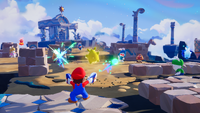
Turn-based tactics games involve turn-based combat gameplay characteristic of an RPG, usually in a warfare-like scenario. The combat involves the player tactfully positioning their characters to attack and defend against enemies. The only games in the Super Mario franchise with this genre are those in the Mario + Rabbids series.
The Mario Party series does also include game modes that merge aspects of both the turn-based tactics and party genres, specifically Toad Scramble in Mario Party: Star Rush and Partner Party in Super Mario Party.
